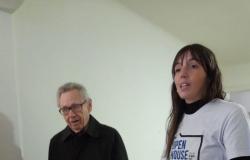Sunday 4/28/2024
/ Last update
César Bisso’s new book is made up of three parts. They have no title, only an epigraph that precedes them. They could have it, because the poems refer to places, people, characters, identities, diverse events, from our country and from more than one continent. But the author takes another, non-linear route, seeking the unity of the whole with the tone of the writing. From the title of the book we get the idea of movement, a kind of active attention, which “happens”, as a poem ends. In fact, he writes: “The only thing that saves me is the road.”
This is what “Andares” is about. Of the need for a path that has many names. A path that is also a walk inward, and towards the bottom, like veins that carry the flow in a breathing body: “My walk undulates through uncertain underground corridors” (“Cuevas de Artá”). And the arc is wide, whether it is the infinite journey of everyday life (¨The Return”), whose flickering light senses the path, or whether it is “The Prophet” who “has always traveled through the cities of the world.”
I clearly remember César Bisso’s poems in which the theme is the river, books that are the river itself, like “The Other River” or “Isla Inside”, which have to do with his native space, Coronda. Now he takes us from the water to the roads. The river is also one of the many forms of paths, as is memory. And there are also other journeys that are as uncertain as they are revealing, and “Andares” gives an account of them: “With the gentle cadence that the camalotes travel/they take you today through quicksand.”
At the outset, we read: “The poem is guilty because it does not know how to be innocent.” The poem is moved by curiosity, by risk. Like the “warrior” in battle, “the poet is always naked in the poem,” Bisso writes. The record of the book moves between a strong and broad load of meaning: “Silence extinguishes the last halo of the street/ and nothing remains, only the fierce life,/ the mud of mystery, the thirst of the corpses,/ the ghostly scream of guitars that falls into the abyss / after a dance without memory” (about the death of Jorge Cafrune); and the stripped-down, direct verse: “I am the dark, remote country.” The theme is the same.
Cover of the book “Andares”, by the Corondian poet César Bisso, published last year.
The dedications in the second part of the book, more than a mention at the bottom, are intertwined in each poem: they are facts that make up its architecture and its essence. In “The Gardener of Deiá”, he writes: “A rugged voice seeks the irrevocable word.” It is the search of Robert Graves, to whom the poem is dedicated, and also that of the author, two voices to give shape to the living myth of poetry. And there are more references to poets, each subtly woven into the poem. For example: Juan Gelman, José Emilio Pacheco, Ledo Ivo, Rubén Vela, Vicente Huidobro, etc.; to singers: Alfredo Zitarrosa, Nina Simone, Atahualpa Yupanqui, the aforementioned Cafrune. “Andares” is made of voices, but also of pure silence, as if silence were a place: “Women who speak behind the silence”, “So much silence sharpens the claws of the puma.”
In the last part, we go from “The candid Tafí with his rusty rails”, in Tucumán, to the duende who “walks loose / shedding prayers”, in Tilcara; from “The miracle is subject to the feet./ Now I understand. The only thing that saves me is the road”, in Talampaya, to “The memory earth explodes under the Andalusian sun”, in Seville; from “A night in Masaya”, in Nicaragua, to “The afternoon surrounds a crown of tannins / on the forehead of the devastated mountain”, in northern Santa Fe.
The poet sees, lives, writes, as a testimony or from contemplation, but without one impeding the other. As in the poem titled “San Francisco del Monte de Oro.” It is the name of a town in the province of San Luis, in a mountain valley. It describes the ranch where Domingo Faustino Sarmiento, in 1826, at the age of 15, founded his first school. But it is more than just a precise and beautiful description: the poem makes it so that things continue to happen around and within the adobe and stone walls, the same things, two hundred years later.
I allow myself to add the reminiscences that the place brings me, because just a hundred meters away I had my second home, where I lived for a few years, and the historic ranch was an obligatory step to go down to the town. As a reader, grateful for allowing me to make this return trip with the poem.
After a long and generous journey through where the book takes us, in the last poem (titled “It Rains in Toay”), which is brief and is transcribed here, the poet returns to his river, to water as language, to his, paradoxically, “support point so as not to fall.”
Literary analysis dedicated to the work “Andares”, by César Bisso. La Yunta Editions, Poetry Series. Buenos Aires, 2023.
It rains in Toay (to Olga Orozco)
It rains in the town where it rarely happens.
I’m sitting on a bench in the square,
in front of the church of sleeping angels
with its needles that stab the sky.
The shadow of a bird in flight
dodge the water’s thrust.
The wind blows against corvos caldenes
in the town where you don’t hear anything.
I imagine the house, lit.
It’s like I’m watching
where the light shelters its beauty.
Purple magnolias in the yard
I follow the footsteps of the ants
for broken tiles.
Under the eaves, a girl enjoys
quince and honey cakes.
The photo delays childhood,
It evokes fragments of joy.
That’s when another rain breaks
inside her green eyesand Toay gets dark on a page.






